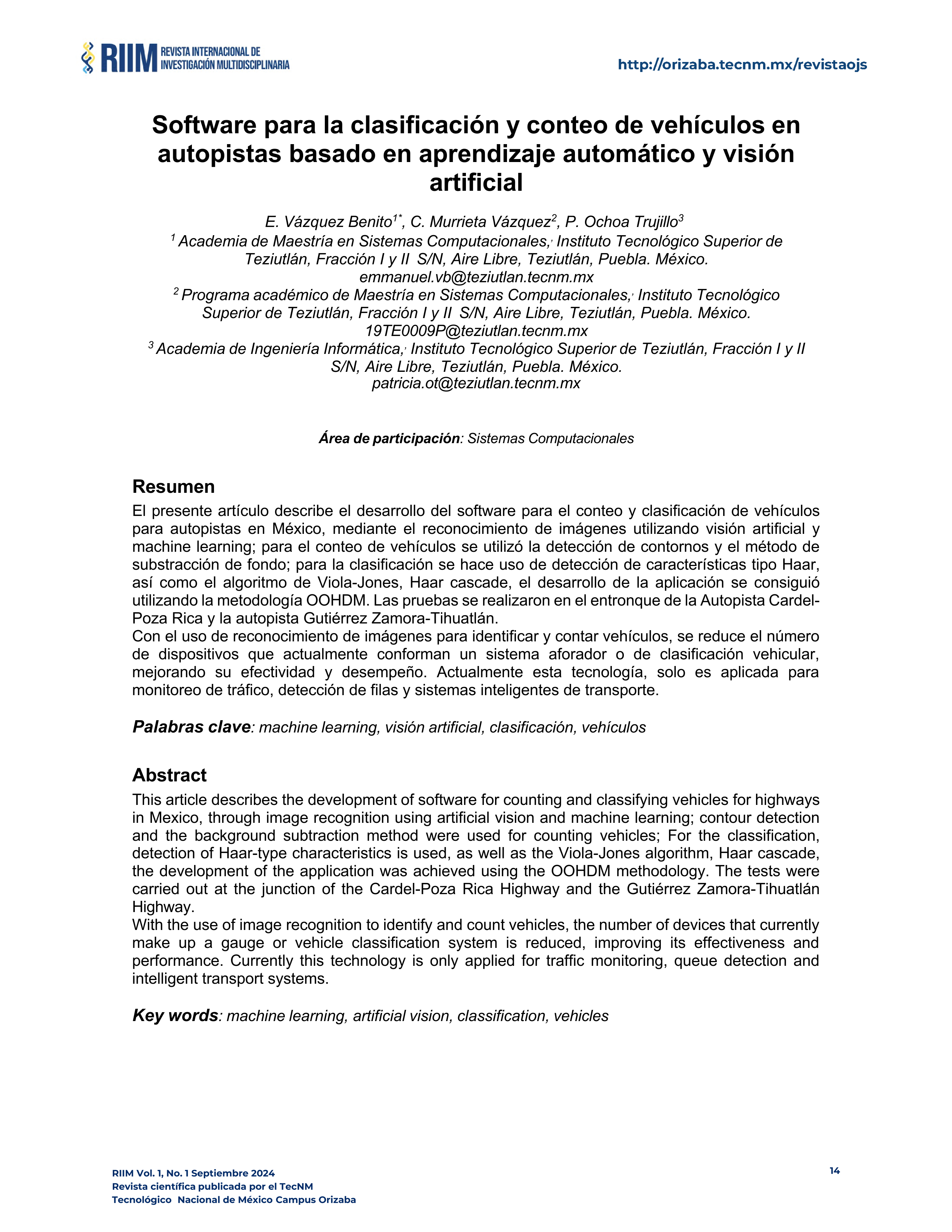Software para la clasificación y conteo de vehículos en autopistas basado en aprendizaje automático y visión artificial
Keywords:
Machine learning, artificial vision, classification, vehiclesAbstract
This article describes the development of software for counting and classifying vehicles for highways in Mexico, through image recognition using artificial vision and machine learning; contour detection and the background subtraction method were used for counting vehicles; For the classification, detection of Haar-type characteristics is used, as well as the Viola-Jones algorithm, Haar cascade, the development of the application was achieved using the OOHDM methodology. The tests were carried out at the junction of the Cardel-Poza Rica Highway and the Gutiérrez Zamora-Tihuatlán Highway. With the use of image recognition to identify and count vehicles, the number of devices that currently make up a gauge or vehicle classification system is reduced, improving its effectiveness and performance. Currently this technology is only applied for traffic monitoring, queue detection and intelligent transport systems.
References
Referencias
Aristizábal, S. G., & Caro, A. S. (2018). Desarrollo de un semáforo portátil inteligente para el control del flujo vehicular. (p. 50). Instituto Tecnológico Metropolitano.
Bas, E., Tekalp, A. M., & Salman, F. S. (2007). Automatic Vehicle Counting from Video for Traffic Flow Analysis. 2007 IEEE Intelligent Vehicles Symposium, 392–397.
Barriga, E. R. C. (2017). Aplicación práctica de la visión artificial para el reconocimiento de rostros en una imagen. 60.
Beltrán, J.C.(2014). Tecnologías inteligentes para salvar recursos energéticos. Ciudad de México ITS México.
Chan, M.J. (2006). Sistema automático de conteo y clasificación de flujo vehicular basado en secuencias de video y redes neuronales artificiales. San Nicolás de los Garza, N.L.
Enrique Urrego, Germán & Calderón, Francisco Carlos, & Forero, Alejandro & Quiroga, Julián Armando (2009). Adquisición de variables de tráfico vehicular usando visión Por computador. Revista de Ingeniería, (30), 7-15.
Erhan Baş, A. Murat Tekalp, Fellow, IEEE, and F. Sibel Salman Automatic Vehicle Counting from Video for Traffic Flow Analysis. College of Engineering, Koç University, 34450 Sariyer, Istanbul, Turkey ISSN: 0121-4993.
Esparza, J. E. M. (2014). Análisis de tráfico vehicular usando visión artificial en la ciudad de San Juan de Pasto. Universidad de Nariño.
Granados, A.F. & Marín H.,J.I. (2007). Detección de flujo vehicular basado en visión artificial. Scientia et Technica ISSN 0122-1701, Vol. 3, No. 35, 3(35), 163-168. Recuperado de https://dialnet.unirioja.es/servlet/articulo?codigo=4803620
Shokravi, H., Shokravi, H., Bakhary, N., Heidarrezaei, M., Rahimian Koloor, S. S., & Petrů, M. (2020). A Review on Vehicle Classification and Potential Use of Smart Vehicle-Assisted Techniques. Sensors, 20(11), 3274.
P. Viola and M. Jones, "Rapid object detection using a boosted cascade of simple features," Proceedings of the 2001 IEEE Computer Society Conference on Computer Vision and Pattern Recognition. CVPR 2001, 2001, pp. I-I, doi: 10.1109/CVPR.2001.990517.







